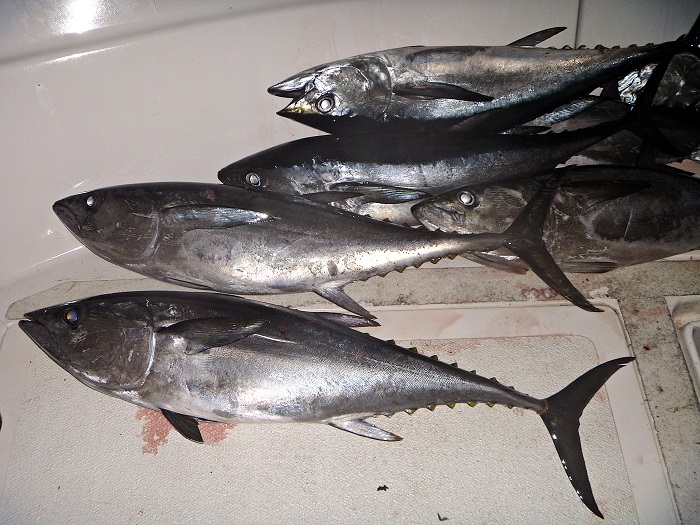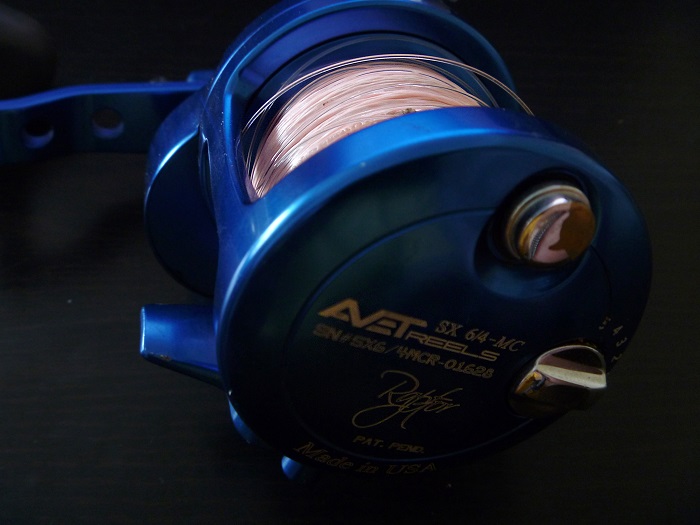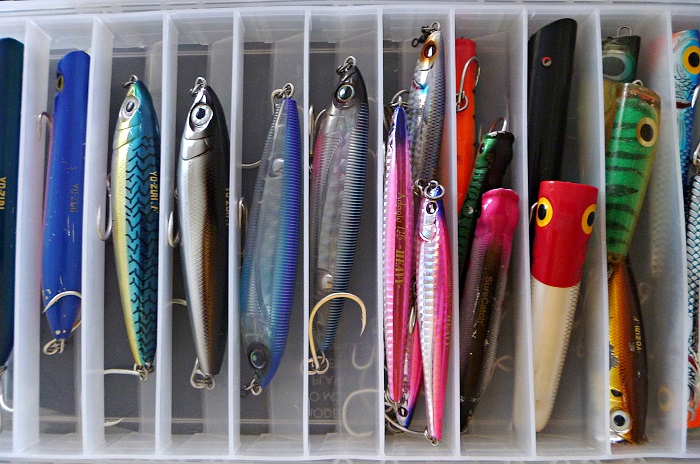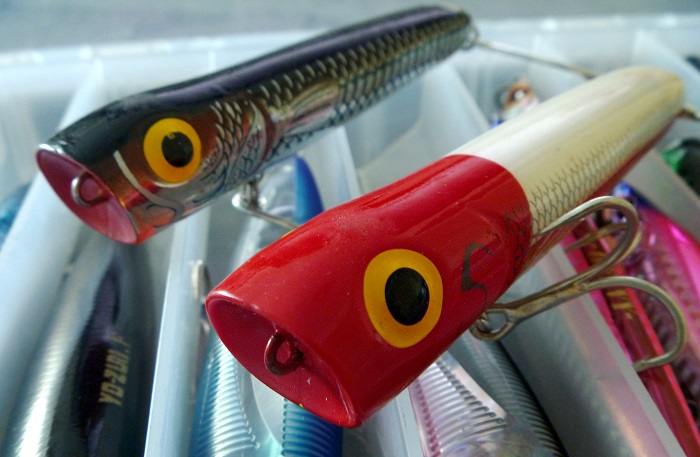A long cast towards the chaos of birds and bursting fish, the short pause while waiting for the top water plug to land was almost unbearable. The pandemonium of fish and birds have moved quite a bit to the right of the boat before the lure landed and I was almost certain that I was out of the strike zone, was it us that moved or the fish? I asked myself. Closing the bail of the reel, I pointed the rod tip up and reeled the lure just fast enough so it skitters on top of the choppy waters, doing this mimics the movement of fleeing baitfish; suddenly a huge eruption behind the lure sent my nerves on high alert, I reel faster and got rewarded with another bigger eruption behind the lure. There were two as I have come to realize as they were side by side it was almost difficult to tell had it not been for one of the fish launching itself airborne, then suddenly I felt a sharp tug that stopped me in my tracks, the rod buckled over and the line started to leave the reel at an alarming rate with the familiar song of the drag filling the air. Looking behind my shoulder I see two other guys with bent rods, we were all screaming, elated by the fact that these were our first tuna of the day, and a triple hook-up, all from our first casts.
Tackle
A decade ago, fishing for tuna with top water lures was uncommon, a handful of people did it with cumbersome rods and thick monofilament lines but the majority of those that chased after tuna were more than likely trollers and live baiters with stout conventional outfits. Even the ones that were doing it stand up style were using cumbersome heavy outfits. These days, you’ll find that most of those going after tuna with top water lures are using relatively light tackle – who would have thought that a decade after, using light tackle on midsized tuna would be commonplace and of all things with spinning gear.
Using light tackle means quite a few things for us:
The entire outfit isn’t heavy, this enables us to fish longer and when we do hook up, we fight more of the fish and less of the weight of the gear. It enables us to cast lures farther, reaching fish that become aware of danger because of the boat’s unnatural noise. But because our subject is tuna, a fish notoriously known for bait profiling, that’s when the fish will strike only bait/lures that are the same size of baitfish they are feeding on, the biggest advantage of using lighter tackle means it enables you to cast smaller lures that are otherwise difficult, if not impossible, to cast a good distance with the tackle used before.

Rods and Reels
My standard is a Shimano Twinpower 8000; it is an excellent reel that’s been serving me well for some time. It is a mid-sized reel that is light enough to be used from shore yet heavy enough to be used offshore on small to midsized tuna and dorado. Yet there are still some that find this reel is a bit too big for their liking. I would not recommend a reel that doesn’t have a metal body – I’m not saying that it won’t catch fish, but the flex of the composite body will give you problems and faced with a strong fish such as tuna, the reel will not have a long life. I have seen a few people fishing for them with a 5000 – 6000 sized reel (Shimano sizing), for me, this is okay unless there is a possibility of encountering bigger fish, if they do decide to show up, an 8000 sized reel will give you the drag power and line capacity to dog it out.
On the conventional side, which is my favourite, I love casting with my Avet SX Raptor. It can cast just as far as my Twinpower but is more comfortable for me to use as my preference leans towards conventional tackle. Since the lures we cast are heavy, casting them with the SX Raptor is a breeze. Although I set mine to zero, the magnetic cast control system is there in case it’s needed, making casting towards the wind a worry free task.

Like the reels, rods have come a long way since. I pair my Twinpower 8000 with a spinning rod designed for popping. The one I’m using isn’t sold in the UAE, but there are lots of quality popping rods available to suit every budget. It will be a challenge to look for a rod that could match a conventional reel such as the Avet SX Raptor as casting with conventional reels isn’t practiced a lot in the region. The thing to remember about casting for tuna is – buy the best possible metal-bodied reel that you can afford and pair it with a good rod for the purpose. I have seen rods broken and reel drags burnt just because they thought their gear was good enough for the task. If you aren’t familiar with this type of fishing, I would suggest you do a little reading online and also ask people who have done it before to get advice on which rod and reel are suitable for the task.
Line
Braid is used to give you more distance, more line capacity and an overall stronger line. Don’t even think about using monofilament. It will work but you’ll get less line on the reel, shorter casts and if you do get a long runner, you’ll feel like you’re fighting the fish with a long piece of rubber band.
A note about braid and something you should be careful about – there are some that cast better than others and for that matter, I stick with braid specifically designed for casting. There are quite a few Japanese brands specifically made for casting, like Suffix. The most important thing before buying a braid is to ask your friends for feedback on the castability of the line. You don’t want to be out in the middle of a tuna boil dealing with a huge tangle while your friends are catching.
Leaders
I’m not fuzzy about leaders; I mostly use mono instead of fluorocarbon. I have used mono and fluorocarbon and to tell you honestly, I have not really seen a big enough gap between the two. I believe, if you feel like you’ll catch more fish with fluorocarbon, then go ahead and use it. If you’re more confident about something, you end up fishing a lot more and not fiddling about. I like really long leaders and usually tie on a fresh length for each trip. I find that I have better control over the fish as soon as the leader material gets wrapped at least a couple of times around the reel.
Connections
There are primarily three schools of thought on how to connect a braided line to the leader. There are those that prefer to cast with the knot that connects their braid and leader outside the rod tip and feel they cast farther – primarily, these are the guys that feel that they get more distance with this system.
Another group is those that use very low profile knots that act more like a splice with the leader material knots such as the PR and FJ knots. Using long leaders that get wound around the spool, this system enables the caster to cast long leaders with very little impact on the distance because of the knots – not everyone agrees though and there are varying accounts.

The last group use premade, wind-on leaders – using a very strong knot that terminates in a loop and attaches the wind on leader via a loop-to-loop connection. This is an expensive way to go and for me, doesn’t really give a lot of advantage, but some guys prefer this system.
Test all three and see what feels comfortable to you and go with that. I prefer long leaders because I mostly cut back on my leader when changing lures, preferring to create a new knot for each lure change and not rely on one knot with a snap at the end when changing lures – it’s a practice that has become a personal preference over the years and although it would be more convenient for me to just use premade wind on leaders, I prefer to tie a PR or FJ knot. I tie a fresh PR or FJ for each trip ensuring I have my desired leader length (which is usually about +/- 10 meters) for each fishing trip. I use this system for all my spin/conventional fishing.
Lures
It is easier to catch tuna with subsurface lures; it’s less complicated, and probably an easier bet to get hooked onto one especially when they are fuzzy. However, catching one on top is explosive and very addictive, the visual aspect of the strike makes you crave for more and gets you addicted to a point where you just want to see the strike and don’t even mind losing the fish.

Poppers and stick baits top the list. The most important thing to remember when choosing one for the task is ensuring it has a thorough wire construction – this means that the wire that holds the hook/hooks is one, solid, piece that runs the length of the lure ensuring the lure stands up to the massive pulling power of tuna and not bend out of the lure.
I like stick baits more than poppers – I have caught tuna on both – this is a personal preference, I just like catching them more on stick baits than I do with poppers. I carry an assortment of poppers, stick baits and casting jigs so I would be able to adjust according to the conditions at hand.
Getting Out There
There are a couple of companies operating in Fujairah that would be able to get you out there. I always go with Soolyman Sport Fishing (www.soolymansportfishing.com) as they have an impeccable track record and so far, have been very reliable. There is a couple charter companies that would be able to get you out there, I’m sure it will be worth your while to snoop around online.
It’s summer but fishing doesn’t have to stop. There are alternatives and opportunities unique to this season, you just have to know where to go and put a bit of effort to the trip and you should be able to enjoy one or a few that would forever change your summertime fishing here in the UAE.
Till next tide change,
Kit
Words + Photos By: Kit Belen

